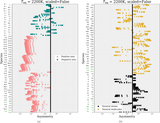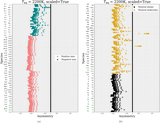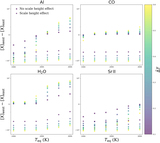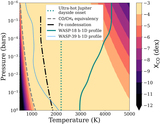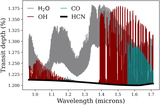Image Details

Caption: Figure 5.
Atmospheric Doppler shifts, which should remain in the HRCCS signal after the orbital motion is subtracted, as a function of orbital phase for our forward models. Shown are representative species that span Doppler shifts and are noted as potentially observable by Kesseli et al. (2022): Fe, Sr II, and Sc. Cloud-free models are represented with solid lines, whereas models with fully cloudy morning limbs are represented with dashed lines. The first half of transit (RV1) and second half of transit (RV2) Doppler shifts for Fe from Kesseli et al. (2022) are overplotted as horizontal lines, with width determined by observational errors. Our cloudy models are much more strongly blueshifted than their cloud-free counterparts, become less blueshifted over transit, and do not have significant CCF peaks at early phases.
Copyright and Terms & Conditions
© 2023. The Author(s). Published by the American Astronomical Society.


